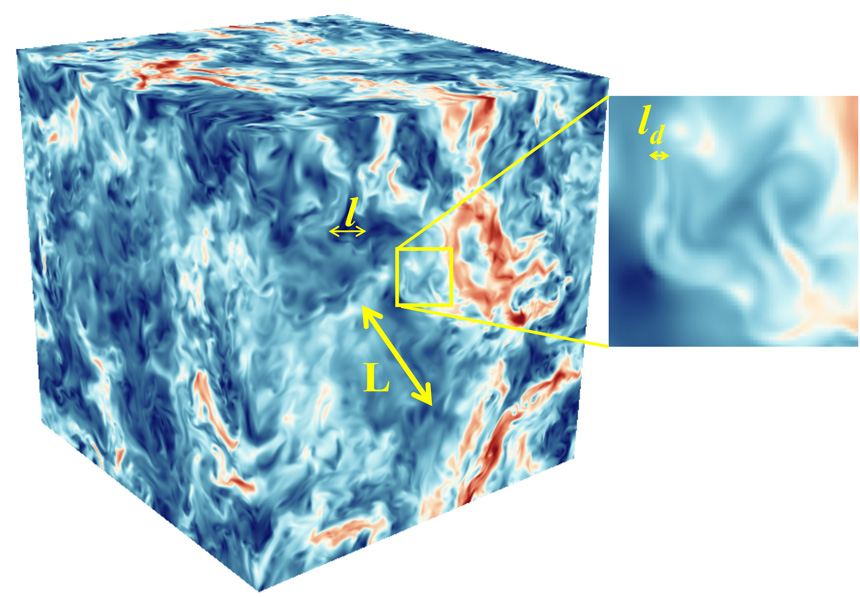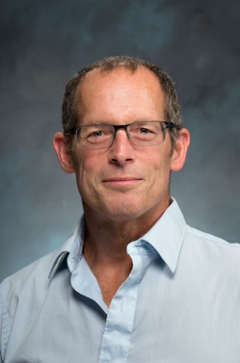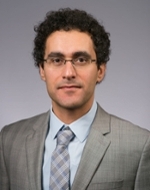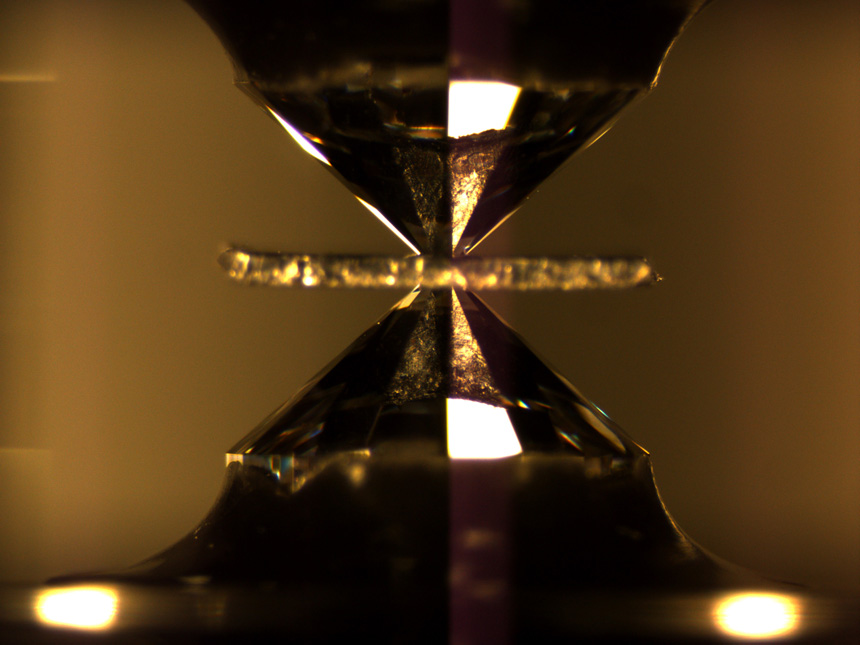MechE faculty at cutting edge of high energy density physics
August 23, 2018

A simulation of turbulence produced with Asst. Prof. Hussein Aluie's code DiNuSUR. The photo was taken by Aarne Lees, a PhD student in Aluie's Turbulence and Complex Flow Group.
What happens to materials when they are subjected to pressures so extreme that all the normal rules of atomic behavior are thrown out the window? Is it possible to achieve the “Holy Grail” that scientists have pursued for decades, namely a superconducting material that could function at or near room temperatures? How accurately can we simulate the fluid instabilities that hinder high-pressure, high-temperature fusion experiments?
These are questions that faculty members in the Department of Mechanical Engineering will explore with four recently awarded grants from the Department of Energy and the National Science Foundation. The awards reflect the growing momentum of a new high energy density physics (HEDP) program at the University of Rochester.
 Including three other grants received by senior scientists at the Laboratory for Laser Energetics (LLE), the University is the largest recipient of HEDP awards in the nation this year.
Including three other grants received by senior scientists at the Laboratory for Laser Energetics (LLE), the University is the largest recipient of HEDP awards in the nation this year.
“We’re starting to coordinate, organize and go after all these opportunities,” says Gilbert “Rip” Collins, director of the program and professor of mechanical engineering. “We’re finding our voice and our vocabulary to communicate the gifts we have here to a broader constituency.”
One of those gifts is the LLE. The OMEGA laser facility there enables scientists to recreate the extreme pressures that:
- are found in distant planets and other astrophysical objects
- can transform matter into new materials for a host of applications here on Earth
- help safeguard the nation’s nuclear weapons stockpile with fusion experiments that provide an alternative to actual weapon testing
- hold the key to creating a clean, sustainable source of energy from fusion.
LLE, for example, is the main laboratory exploring direct drive inertial confinement fusion as a source of energy. The combined force of 60 pulsed laser beams, converging from all directions, is used to implode a fuel capsule containing deuterium and tritium. The goal, still not achieved, is to bring this fuel to sufficiently high pressures and temperatures to cause the isotopes to fuse and then ignite.
Here are the projects mechanical engineering faculty members will be working on:
Converging towards atomic and nuclear pressures
How do you disrupt the shell structure of atoms and “open the door to a new type of quantum matter”?
One way is to use convergent shock-wave techniques to compress hydrogen isotopes beyond atomic scale pressure.
A $699,000 grant from DOE’s Office of Fusion Energy Sciences will enable Collins; Ryan Rygg, a senior scientist at LLE and assistant professor of mechanical engineering; and researchers at Lawrence Livermore National Laboratory’s National Ignition Facility (NIF) to further refine and use just such an approach.
The resulting transition of the isotopes to dense plasma, and beyond, could provide important insights for both astrophysics and the quest for inertial confinement fusion.
For example, some 3,000 recently discovered planets – and even more stars – are composed of matter at millions to many billions of atmospheres of pressure. “There are a number of observational scientists making tremendous, profound discoveries of massive bodies that exist outside our solar system, but that data is limited,” Collins says. “There is only so much information we can collect. We need to have a deep understanding for how materials behave in the deep interiors of these massive objects. The only way to recreate those conditions are with the lasers here and at NIF.”
Because the experiments use solid or liquid balls, or very thick shells as targets, the convergent shock waves are inherently stable, “providing a unique way to explore the mechanical to thermal or compressive energy conversion efficiency in spherical geometries, a process that may prove useful in inertial confinement fusion experiments,” the researchers note in their proposal.
Unraveling complex flows in extreme environments
Our understanding of complex flows under the extreme conditions encountered in HEDP applications, such as ICF or supernova explosions, is relatively under developed due to inaccurate or incomplete models, and a limitation in our current experimental diagnostics that can directly interrogate flows under such conditions.
More accurate computer simulations would be useful; if simulations could accurately mirror the fluid instabilities that currently hinder inertial confinement experiments, for example, they could better guide researchers in how to change the way ICF experiments are conducted.
 Hussein Aluie’s work on this challenge has been aided the last two years with an award of 137 million hours of access to a supercomputer at Argonne National Laboratory. Now the assistant professor of mechanical engineering has received $300,000 in funding from the Office of Fusion Sciences to collaborate with Ricardo Betti, LLE’s chief science officer and ICF expert, on incorporating an additional variable in the simulations: magnetic fields.
Hussein Aluie’s work on this challenge has been aided the last two years with an award of 137 million hours of access to a supercomputer at Argonne National Laboratory. Now the assistant professor of mechanical engineering has received $300,000 in funding from the Office of Fusion Sciences to collaborate with Ricardo Betti, LLE’s chief science officer and ICF expert, on incorporating an additional variable in the simulations: magnetic fields.
When lasers converge on the exterior of the deuterium/tritium fuel capsule during an inertial confinement fusion experiment, fluid instabilities occur when the lasers turn the outer shell into a hot, low-density plasma that pushes against the colder, denser shell inside, Aluie explains. As a result, “different materials start inter-penetrating through each other, like fingers, degrading the implosion. Such mixing removes heat from the center and brings in impurities from the outside. The target’s core fails to reach sufficiently high temperatures and densities.”
Part of Aluie’s work with this grant is to better understand how magnetic fields created during this Raleigh-Taylor instability affect heat transfer. There is also a possibility that magnetic fields could be deliberately imposed to reduce the instability itself.
“Two studies have been done on how this would affect Raleigh Taylor Instability, and they came to opposite conclusions,” Aluie says. “That’s the other part we’re looking at.”
 Jessica Shang will address the issue of better simulations by working with Betti, Aluie, and Rygg on an “iterative approach”: using lasers to produce and probe turbulent flows and using the experimental data to refine the physics underlying the simulations.
Jessica Shang will address the issue of better simulations by working with Betti, Aluie, and Rygg on an “iterative approach”: using lasers to produce and probe turbulent flows and using the experimental data to refine the physics underlying the simulations.
“Some of the limitations of the simulations now used arise because a lot of our knowledge about how turbulence behaves is based on what happens in an ‘incompressible’ environment (where fluid density doesn’t change significantly in space or time),” says the assistant professor of mechanical engineering. For example, turbulence in the atmosphere, where a cascade effect occurs as energy is gradually dissipated from large to progressively smaller eddies.
“But we don’t know so much about what happens in compressible turbulence” -- In an inertial confinement fusion experiment, for example.
Shang’s project is funded with a $615,000 grant from DOE.

A diamond anvil cell used in the lab of Ranga Dias to compress and alter the properties of hydrogen rich materials. The goal: novel materials that could be superconductive at or near room temperature.
In pursuit of the Holy Grail
Ranga Dias doesn’t use high power lasers to change matter and he doesn’t try to do it in mere millionths of a second. The assistant professor of mechanical engineering and physics uses diamonds instead, in experiments that can stretch over days, even months.
 Diamond anvil cells – basically two diamonds placed opposite each other, with a gasket in between – allow Dias and his students to gradually compress tiny amounts of hydrogen rich materials within equally tiny spaces, forcing the atoms in those materials to squeeze more and more tightly together and altering the properties of those materials in many fundamental ways.
Diamond anvil cells – basically two diamonds placed opposite each other, with a gasket in between – allow Dias and his students to gradually compress tiny amounts of hydrogen rich materials within equally tiny spaces, forcing the atoms in those materials to squeeze more and more tightly together and altering the properties of those materials in many fundamental ways.
“This provides exciting opportunities to discover new materials, novel phenomena, and exotic states of matter that are not present at ambient conditions,” Dias says.
For example, this could turn hydrogen into a solid metallic phase that, it is predicted, would be superconductive at room temperatures, transmitting electricity without any dissipation or loss. This would be the Holy Grail that physicists and materials scientists have sought for decades, greatly reducing energy costs and transforming our transportation (think magnetic levitated trains, for example). However, the pressures required to do this are so high, that the cost to produce sufficient quantities of metallic hydrogen would far exceed the benefits, Dias says.
Instead, with a $484,000 grant from the National Science Foundation, Dias will synthesize new materials that include hydrogen, but can be metalized at much lower pressures, mimicking the elusive solid metallic phase of hydrogen. He will then explore their possible superconductivity at or near room temperature. For example, Dias has had “promising preliminary results” by combining carbon, hydrogen, and sulfur, one of the possibilities he will explore.
“To have a really high superconductor, you want stronger bonds, light elements. Those are the two very basic criteria,” Dias says. “Hydrogen is the lightest material, and the hydrogen bond is one of the strongest. So even as we explore other materials, it is in combination with hydrogen.”
